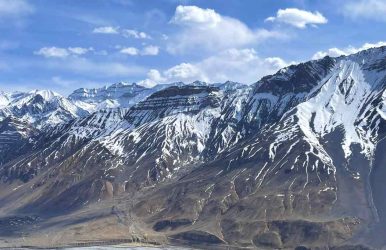Which Is The Best Time To Visit Spiti Valley? – Travel Guide
BY Nabamita Sep 5, 2022
If you are in love with the rough terrains of the mountain road and Leh Ladakh is already checked off your bucket list. Then you need to visit this beautiful hidden gem of Himachal Pradesh, Spiti Valley. From trekking to camping, nothing is impossible here in Spiti Valley, but you might as me what is the best time to visit Spiti valley; well, keep scrolling to find out. Spiti Valley: The Middle Land The cold mountain desert of Himachal Pradesh is a paradise for mountaineers and campers. But don’t get me wrong, Spiti Valley is much more than rough mountain terrain; it is full of cultural and natural beauty. It is known for the heavy influence of Buddhist Culture; it is a place for tranquillity. Being situated at great heights, it has drastic weather changes, which makes it difficult to visit at a random time of the year. It is important that you know what is the best time to visit Spiti valley. Best Time To Visit Spiti Valley Whether you are solo backpacking through the terrains of Spiti valley or out with your whole family, it is important to know the weather changes. March to JuneJuly to SeptemberOctober to February14c to 20c13c to 27c-4c to 20c March - June If you are planning Spiti valley tours, then this is the ideal time for you to visit there. From March till June, the temperature is comfortable and quite pleasant for all your outdoor activities. If you are someone who can’t handle too much cold, then Spiti valley best time to visit is now. During this, there are a lot of fun outdoor activities you can enjoy and appreciate, like camping, trekking, sightseeing, and also biking. These outside activities are a few of the best tourist attractions here in Spiti valley. So to enjoy these, visit during these months. July - September From the months of July till September is definitely not the best time to visit Spiti valley. These are the monsoon months in Spiti Valley, which is at high risk for landslides and other dangers. No tourist should visit during the monsoon months here in Spiti valley. October - February For thrill-seekers and adventurers, if you are great with the cold and snow, visit Spiti valley during these months. You will witness the real heaven on earth. Spiti valley during the winter months is, in a word, “Magnificent.” Everything is covered in snow and would feel like a white winter wonderland. But it is also important to note that even though it’s beautiful during the winter, the climate can be very harsh. During the night, the temperature can fall to even -40c; it is especially during the harsh winter of December. Different Climates In Spiti Valley Like any other place, Spiti valley typically has three distinct climates and that is summer, monsoon and winter. ☀️Summer In Spiti Valley The month of April usually marks the onset of summer in the Spiti valley, and it lasts till the end of June. And this is the peak time for tourists to visit Spiti valley, as, during this time, the Manali road going towards Spiti valley opens. From late May till mid-June is the best time to visit Spiti valley. During this time, the temperature rises above 0c. You should also visit Spiti valley during summer as during these months you can experience a lot of outdoor activities. These are why this is the best time to visit Spiti valley. ☔Monsoon In Spiti Valley The rain comes pouring down in Spiti valley during the months of July till September. Not only is traveling difficult during this time, but it is also rather dangerous and highly risky. The roads are full of mud and waterfalls, and the risk of landslides is relatively high. Tourists and travelers often get stuck on the road during the monsoon season in Spiti valley. And it is also kind off impractical to visit Spiti valley during the monsoon season as the heavy rainclouds block the beautiful scenic view of the Spiti valley. ❄️Winter In Spiti Valley Winter months normally sets in the Spiti valley during the months of October and continues till March. The temperature drops to minus degrees steadily that turning the valley into a cold, snowy desert. The main route, which is the Manali route til Spiti, is closed during winter, so you have to take the Kargil and Srinagar routes during the winter. Though the winter months in Spiti valley are heavenly, it is not always recommended due to dangerous roads and extreme temperatures. Places To Visit In Spiti Valley Spiti valley is an abode to countless beautiful destinations for you to experience, like waterfalls, mountain rivers, glaciers, treks, and monasteries. Here are a few of the places in Spiti valley you should definitely visit. 🏞️Chandratal Lake The Chandratal lake is situated in the Samudra Tapu Plateau and is located 4300 m high in the lap of the Himalayas. Covered by mountains on one side and beautiful cirques on the other side, it creates beautiful scenery. 🌄Kaza Kaza is one of the most well-known places in Spiti valley. It is a sub-divisional headquarters of Spiti valley. It is also divided into two parts, namely, Kaza Khas and Kaza Soma. 🏔️Kinnaur Kinnaur is a very beautiful and popular district of Himachal Pradesh that has a captivating view of snow covered mountain ranges. The mountain range is from the Zaskar range and the Himalayas. 🏞️Nako Nako is a beautiful village that has the most wonderful view and surroundings. It is known as the most beautiful village in Spiti valley. 🏯Key Monastery The Key Monastery is considered to be one of the most popular Buddhist monasteries in the Spiti and Lahaul District in India that has Tibetan roots. ⛩️Kunzum Pass Kunzum Pass is one of India’s highest mountain passes that is motorable. It stands like a gateway from Kullu and Lahaul valley to Spiti valley. 🌅Tabo Tabo is a small Tibetan town in Spiti Valley, lying on the border of the Indo-Tibetan border, on the banks of the Spiti River. Frequently Asked Questions (FAQs): If you have any more queries regarding Spiti valley, then here are some of the questions asked by others. 1. How Many Days Should I Spend In Spiti Valley? Ans: To explore Spiti valley in totality, you should at least spend 8-10 days. It takes about 5 to reach Spiti valley if you are taking the Kinnaur route. So it is better to have a few days in hand to explore the place. 2. Can I See Snow In Spiti Valley? Ans: If you are planning to see snow here in Spiti valley, then the best time for you to visit is during the winter months. It is from January to March. 3. Is Spiti Valley Worth Visiting? Ans: Absolutely Yes, if you are someone who loves the mountains and is in love with adventures, then it is a must-visit Spiti valley. It is a piece of heaven on earth. Visit Now! Spiti valley is one of those places you need to visit once to experience what it means to have an adventure. Now that you know the best time to visit Spiti valley, why not book your tickets here for your next holiday? Read Also: What Are The Places To Visit In Meghalaya? – Travel Guide Top 7 Best Places To Visit In Darjeeling – Travel Guide Which Is The Largest Freshwater Lake In India?












